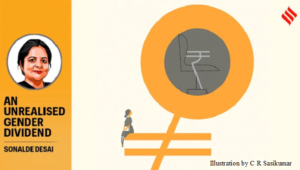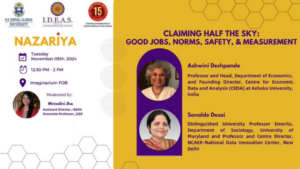Opinion: Sonalde Desai and Debasis Barik.
[The Indian Express, October 25, 2024]
If south India wants a larger population, it needs to focus on family-friendly policies or encourage migration from more populous states.
In 1944, Stalin (Joseph not MK) established the Mother Heroine award for women who had given birth to 10 or more children. In the wake of population decimation during World War II, motherhood was glorified as a service to Russia with honour, stipends, and a promise of early retirement. Nonetheless, Russian fertility followed the rest of Europe, reaching a low Total Fertility Rate (TFR) of 1.16 in 1999. The original awards were abolished in 1995, but new rewards for motherhood were established in 2008. Nevertheless, after a temporary rebound, Russian fertility fell to TFR of 1.4.
This story has a lesson for modern-day South Indian leaders, MK Stalin and Chandrababu Naidu. It suggests that appeals to national interests or financial rewards do little to convince families to have more children if they do not see this in their interest.
What does the global fertility transition tell us about very low fertility? Three aspects of the European and East Asian experiences deserve attention. First, European fertility has shown interesting gyrations over the past three decades, dropping to “lowest-low fertility” of 1.3 or lower around 2000 and then rebounding to 1.8 or 1.9 by 2010, before falling again to 1.4-1.6 in 2023. It would be tempting to take a snapshot at any given time and argue that falling fertility is due to declining value of family and increasing fertility is due to the importance of government incentives for more children.
However, demographers like John Bongaarts, Griffith Feeney, and Tomas Sobotka caution us against generalising from TFR. The TFR is a mathematical construct summarising the fertility rates of different generations. When the age at marriage rises, it may lead to an artificial slump in fertility, reducing fertility for women in their 20s but increasing when they marry and have children later, affecting the tempo of fertility, not overall fertility. Europe’s very low fertility circa 2000 experienced a rebound between 2005 and 2015 due to this tempo effect; for example, Russian fertility rose from 1.16 in 1999 to 1.51 in 2008. As education increases and marriage age rises in India, we may also see a temporary decline to very low fertility levels.
The second lesson for us comes from East Asia. Korea, Singapore and even China are experiencing extremely low fertility rates, with Korea having the lowest TFR in the world, 0.8. Here, low fertility is not a function of the lack of importance of children but rather of too much importance given to parenting and the responsibilities of mothers. It leads to immense investments in a single precious child. Research by Alaka Basu and Sonalde Desai has documented that even in India, parents often limit themselves to one child to invest in his or her education. Improving the quality of public education and reducing the time burden on parents to supervise children’s education may reduce pressure on parents to engage in a trade-off between having more children and improving the future opportunities for their children.
In China, the government relaxed the one-child norm, allowing women to have up to three children with little effect on Chinese fertility. Reduction in childcare support by the state during economic liberalisation led to a decline in women’s labour force participation from over 90 per cent to 61 per cent and simultaneously reduced fertility. In contrast, Sweden has been a family-friendly country, and from 2015 to 2020, its fertility rate was 1.9 with some annual fluctuations. Generous maternity and paternity leave, excellent childcare, and social norms encouraging couples to share work and parenting responsibilities have helped make having children more accessible.
Apart from global lessons, we must not forget our own experiences. Naidu has proposed allowing only people with two or more children to contest elections. However, manipulating fertility via election eligibility has been ineffective in the past. In 2001, five states, Andhra Pradesh, Haryana, Madhya Pradesh, Rajasthan, and Odisha, banned the election of people with large families. IAS Officer Nirmala Buch studied these states and found these restrictions were simply ignored. Why do we think the opposite restriction will have any effect?
Most importantly, in a democratic society, whether to have a child or not to have a child is a fundamental human right. As sociologist Judith Blake famously noted, People do not have birth rates; they have children. If Andhra and Tamil Nadu want larger populations, they have two options. Either emulate Sweden and put family-friendly policies in effect that support families or encourage migration from more populous states of north India to combat population ageing and reduce the impact of potential delimitation.
Desai is professor and centre director, NCAER National Data Innovation Centre and Barik is senior fellow, NCAER. Views are personal.










